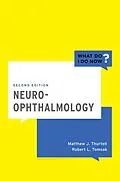Part of the "What Do I Do Now?" series, Neuro-Ophthalmology uses a case-based approach to cover common and important topics in the examination, investigation, and management of afferent visual, efferent eye movement, eyelid, pupil, and orbital disorders. Each chapter provides a discussion of the diagnosis, key points to remember, and selected references for further reading. For this new edition, all cases and references have been updated and new cases have been added, including neuroretinitis, autosomal dominant optic atrophy, carotid-cavernous fistula, and more. Neuro-Ophthalmology is an engaging collection of thought-provoking cases which clinicians can utilize when they encounter difficult patients. The volume is also a self-assessment tool that tests the reader's ability to answer the question, "What do I do now?"
Autorentext
Matthew Thurtell, MBBS, is Associate Professor of Ophthalmology and Neurology at the University of Iowa, with appointments in the Department of Ophthalmology and Visual Sciences and Department of Neurology. He is Director of the Neuro-Ophthalmology Service at the University of Iowa, where has been on faculty since 2010. His clinical practice incorporates the spectrum of neuro-ophthalmic disorders. His research interests include eye movement disorders and idiopathic intracranial hypertension. He is currently Study Co-Director for the Surgical Idiopathic Intracranial Hypertension trial (SIGHT). Robert L. Tomsak, MD, PhD is Professor of Ophthalmology and Neurology at Wayne State University School of Medicine in Detroit Michigan, and Specialist in Neuro-ophthalmology at Kresge Eye Institute. He has practiced neuro-ophthalmology at the Cleveland Clinic Foundation, Mt. Sinai Medical Center in Cleveland and University Hospitals of Cleveland before moving to Kresge Eye Institute in Detroit, Michigan in 2010. His clinical practice includes a wide variety of neuro-ophthalmic disorders. His current research interests include the use of multifocal ERG in the diagnosis of nutritional amblyopia and the use of OCT and OCT-A in assessing papilledema in Idiopathic Intracranial Hypertension.
Inhalt
Section I: Afferent Disorders 1. Optic Neuritis 2. Arteritic Ischemic Optic Neuropathy 3. Non-Arteritic Ischemic Optic Neuropathy 4. Compressive Optic Neuropathy 5. Leber's Hereditary Optic Neuropathy 6. Autosomal Dominant Optic Atrophy 7. Neuroretinitis 8. Papilledema 9. Idiopathic Intracranial Hypertension 10. Pseudopapilledema 11. Chiasmal Syndromes 12. Homonymous Hemianopia 13. Disorders of Higher Visual Function 14. Visual Auras, Hallucinations, and Illusions 15. Transient Vision Loss 16. Unexplained Vision Loss 17. Non-Organic Vision Loss Section II. Efferent Disorders 18. Third Nerve Palsy 19. Fourth Nerve Palsy 20. Sixth Nerve Palsy 21. Intermittent Diplopia 22. Ocular Myasthenia 23. Infranuclear Ophthalmoplegia 24. Internuclear Ophthalmoplegia 25. Supranuclear Ophthalmoplegia 26. Gaze-Evoked Nystagmus 27. Downbeat Nystagmus 28. Upbeat Nystagmus 29. Pendular Nystagmus 30. Infantile Nystagmus 31. Saccadic Intrusions and Dysmetria Section III: Eyelid Disorders 32. Eyelid Ptosis 33. Benign Essential Blepharospasm Section IV: Pupil Disorders 34. Anisocoria 35. Horner's Syndrome 36. Tonic Pupil Section V: Orbital and Mischellaneous Disorders 37. Thyroid Eye Disease 38. Syndromes of the Orbital Apex, Superior Orbital Fissure, and Cavernous Sinus 39. Carotid-Cavernous Fistula 40. Dorsal Midbrain Syndrome
